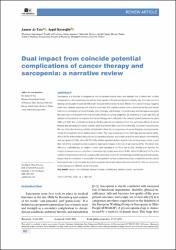Dual impact from coincide potential complications of cancer therapy and sarcopenia: A narrative review

Göster/
Erişim
info:eu-repo/semantics/openAccessAttribution-NonCommercial-NoDerivatives 4.0 Internationalhttps://creativecommons.org/licenses/by-nc-nd/4.0/Tarih
2022Üst veri
Tüm öğe kaydını gösterKünye
Al-Taie, A. ve Köseoğlu, A. (2022). Dual impact from coincide potential complications of cancer therapy and sarcopenia: A narrative review. Oncology in Clinical Practice, 18(5), 302-325. https://doi.org/10.5603/OCP.2021.0023Özet
Sarcopenia is a disorder of progressive loss of skeletal muscle mass and strength that is linked with multiple complications, decreased physical activity, lower quality of life and accelerated mortality rate. It is more common among cancer patients and identified with reduced tolerance by the toxic effects from cancer therapy, negative outcomes, lowered response and overall survival rate. This narrative review aims to demonstrate the dual impact from the co-occurrence of cancer therapy; chemotherapy, radiotherapy, immunotherapy, and sarcopenia alongside the potential complications from their coincide effects on cancer prognosis. By searching through data sets, all articles that focused on sarcopenia and cancer therapy were collected in the indexed journals between the years 2000 and 2021 that could provide findings for the potential complications from the coinciding effects of cancer therapy and sarcopenia in cancer patients receiving chemo-radio- and immunotherapy. Outcome measures were the rate of studies showing potential complications from the co-occurrence of cancer therapies and sarcopenia. A total of hundred-two cohort studies were enrolled. The majority were about chemotherapy and sarcopenia (45%). About 56.9% of the studies designed as retrospective analysis, and a high proportion were about chemotherapy and sarcopenia (21.6%). About 63.7% of the studies reported skeletal muscle index as the primary marker. Lower than half of the reviewed studies revealed a significant increase in the rate of sarcopenia (47%). The direct toxic effects of chemotherapy on skeletal muscle were reported in 13.7% of the studies. Studies that reported the impact of sarcopenia on a reduction in chemotherapy cycles were about 10.8%. About 11.8% and 14.7% of the studies showed lowered overall survival by the coinciding impact of chemotherapy/radiotherapy and sarcopenia, respectively. In conclusion, the evaluation of sarcopenia in cancer patients should be considered a primary part of oncological care in cancer patients as there are potential complications and poor survival from the co-occurrence of sarcopenia and different cancer therapies.


















